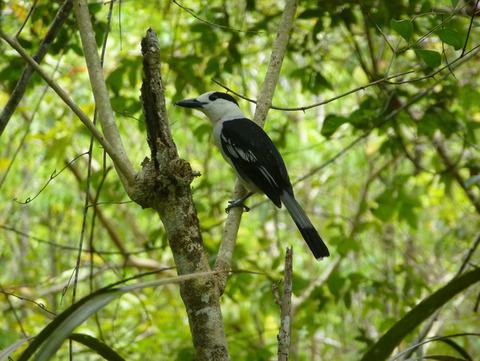当前位置:
X-MOL 学术
›
Biotropica
›
论文详情
Our official English website, www.x-mol.net, welcomes your
feedback! (Note: you will need to create a separate account there.)
Bird diversity and endemism along a land‐use gradient in Madagascar: The conservation value of vanilla agroforests
Biotropica ( IF 1.8 ) Pub Date : 2020-10-07 , DOI: 10.1111/btp.12859 Dominic Andreas Martin 1 , Rouvah Andriafanomezantsoa 2 , Saskia Dröge 1, 3 , Kristina Osen 4 , Eric Rakotomalala 2 , Annemarie Wurz 5 , Aristide Andrianarimisa 2 , Holger Kreft 1, 6
Biotropica ( IF 1.8 ) Pub Date : 2020-10-07 , DOI: 10.1111/btp.12859 Dominic Andreas Martin 1 , Rouvah Andriafanomezantsoa 2 , Saskia Dröge 1, 3 , Kristina Osen 4 , Eric Rakotomalala 2 , Annemarie Wurz 5 , Aristide Andrianarimisa 2 , Holger Kreft 1, 6
Affiliation

|
Land‐use change is the most important driver of biodiversity loss worldwide and particularly so in the tropics, where natural habitats are transformed into large‐scale monocultures or heterogeneous landscape mosaics of largely unknown conservation value. Using birds as an indicator taxon, we evaluated the conservation value of a landscape mosaic in northeastern Madagascar, a biodiversity hotspot and the center of global vanilla production. We assessed bird species richness and composition by conducting point counts across seven prevalent land‐use types (forest‐ and fallow‐derived vanilla agroforests, woody and herbaceous fallow that are part of a shifting cultivation system, rice paddy, forest fragment and contiguous old‐growth forest). We find that old‐growth forest had the highest species richness, driven by a high share of endemics. Species richness and community composition in forest‐derived vanilla agroforest were similar to forest fragment, whereas fallow‐derived vanilla agroforest was most comparable to woody fallow. The open land‐use types herbaceous fallow and rice paddy had fewest species. Across forest fragments, vanilla agroforests, and woody fallows, endemic bird species richness was positively correlated to landscape‐scale forest cover. We conclude that both fallow‐ and forest‐derived vanilla agroforests play an important but contrasting role for bird conservation: Fallow‐derived agroforests are less valuable but take fallow land out of the shifting cultivation cycle, possibly preventing further degradation. Conversely, forest‐derived agroforests contribute to forest degradation but may avoid total loss of tree cover from forest fragments. Considering the land‐use history of agroforests may thus be a promising avenue for future research beyond the case of vanilla.
中文翻译:

马达加斯加土地利用梯度上鸟类的多样性和特有性:香草农林的保护价值
土地利用变化是造成全球生物多样性丧失的最重要因素,特别是在热带地区,那里的自然栖息地已转变为大规模的单一养殖或具有未知保护价值的异质景观马赛克。我们以鸟类为指标类群,评估了马达加斯加东北部,生物多样性热点和全球香草生产中心的景观马赛克的保护价值。我们通过对七种常见的土地利用类型(森林和休耕的香草农林,木质和草本休耕地,正在转变的耕作系统,稻田,森林碎片和邻近的旧土地利用)进行点计数来评估鸟类物种的丰富度和组成生长林)。我们发现,由于地方特有种所占比例较高,老龄森林物种丰富度最高。源自森林的香草农用林的物种丰富度和群落组成与森林片段相似,而源自休闲的香草农用林与木本休闲林的可比性最高。开放性土地利用类型的休耕和稻田物种最少。在森林碎片,香草农林和木质休耕地上,特有鸟类物种的丰富度与景观森林覆盖率呈正相关。我们得出结论,休耕和森林衍生的香草农用林在鸟类保护中都起着重要但相反的作用:休耕的农用林的价值较低,但将休耕地排除在不断变化的耕种周期之外,有可能防止其进一步退化。相反,源自森林的农用林可导致森林退化,但可以避免森林碎片造成的树木覆盖物完全丧失。
更新日期:2020-10-07
中文翻译:

马达加斯加土地利用梯度上鸟类的多样性和特有性:香草农林的保护价值
土地利用变化是造成全球生物多样性丧失的最重要因素,特别是在热带地区,那里的自然栖息地已转变为大规模的单一养殖或具有未知保护价值的异质景观马赛克。我们以鸟类为指标类群,评估了马达加斯加东北部,生物多样性热点和全球香草生产中心的景观马赛克的保护价值。我们通过对七种常见的土地利用类型(森林和休耕的香草农林,木质和草本休耕地,正在转变的耕作系统,稻田,森林碎片和邻近的旧土地利用)进行点计数来评估鸟类物种的丰富度和组成生长林)。我们发现,由于地方特有种所占比例较高,老龄森林物种丰富度最高。源自森林的香草农用林的物种丰富度和群落组成与森林片段相似,而源自休闲的香草农用林与木本休闲林的可比性最高。开放性土地利用类型的休耕和稻田物种最少。在森林碎片,香草农林和木质休耕地上,特有鸟类物种的丰富度与景观森林覆盖率呈正相关。我们得出结论,休耕和森林衍生的香草农用林在鸟类保护中都起着重要但相反的作用:休耕的农用林的价值较低,但将休耕地排除在不断变化的耕种周期之外,有可能防止其进一步退化。相反,源自森林的农用林可导致森林退化,但可以避免森林碎片造成的树木覆盖物完全丧失。











































 京公网安备 11010802027423号
京公网安备 11010802027423号